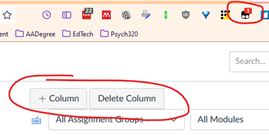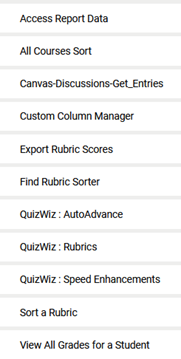Canvas enhancements
One of the advantages of using the Canvas learning management system is that it is built on a platform that makes it easy to make it do things that its inherent programming doesn’t allow it to do. By “easy,” I mean easy for those who know how to write the scripts and easier for us who only need to install the scripts others have written.
Using a web browser add-in called Tampermonkey (yes, it is called Tampermonkey; download for Chrome; download for Firefox), we can run scripts in your browser that will change how Canvas behaves. For example, there is a Tampermonkey script that allows you to export data from your scored rubrics. There is a speedgrader enhancement that allows you to click one button to submit a comment and advance to the next student. There is another Tampermonkey script that allows you to reorder the criteria in a rubric. Yet another script allows you to add custom columns to your gradebook; I’ve added “preferred name,” “fun facts,” “challenges,” and “major” to mine.
The good folks at the University of Colorado Boulder’s Office of Information Technology (OIT) have a page that lists many Canvas enhancements. After you’ve installed Tampermonkey, take a look at their page. When you find an OIT-provided enhancement you’d like, click the “Using <name of enhancement>” bar directly under the enhancement’s description. Click the link to the “<name of enhancement> source page”. On that page, click the Install button. Done. You are good to go.
For example, I have installed the OIT Custom Columns Manager. When I visit my Canvas gradebook, I have two new buttons: + Column and Delete Column. Also, I can see the Tampermonkey icon in my browser’s add-on bar has the number 1 on it. That means that Tampermonkey is running one script on this page.

At the bottom of the OIT Canvas Enhancements page is a section titled “Community-Provided Enhancements.” Many of these scripts have been written by James Jones, a Canvas master (visit his GitHub page to access all of his scripts).
A quick troubleshooting note. Some Canvas courses are hosted by Canvas’s parent company Instructure. Those courses have an instructure.com web address. Other courses are hosted by institutions. Those courses have a canvas.xxx.edu web address. Since the scripts run on webpages, the scripts have to have a web address included in them so Tampermonkey knows when it should run a particular script. Click on the Tampermonkey icon in your browser and select Dashboard. Click on the script name to see the code.
Near the top of the OIT script for the Custom Column Manager, we see this:
// @include https://canvas.*.edu/*/gradebook
// @include https://*.*instructure.com/*/gradebook
This means that the script will run on both website sources.
Some of the community-provided enhancements, though, only have the instructure.com line. If your instance of Canvas is at instructure.com, you’re good to go. For the rest of us, we need to add the line:
// @include https://canvas.*.edu/*/gradebook [The ending of the url will be different depending on the script. Just make sure the ending matches the ending of the instructure.com line.]
One more caveat. If you use Canvas on, say, your home computer and your work computer, you will need to install Tampermonkey and whatever scripts you’re using on both computers. And if you move back and forth between Chrome and Firefox, again, you’ll need to add the scripts to both browsers.
If you run into any trouble, email me at sue@suefrantz.com.
Here are the scripts I have installed, if you’re looking for a starting place. Highly recommended: All Courses Sort, Custom Column Manager, Export Rubric Scores (a wealth of assessment data), and Sort a Rubric.
